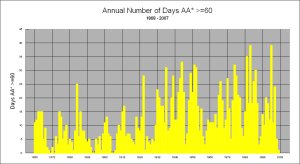Major Magentic Storms 1868-2007
| |||||

Click on image to see larger graph |
A simple global index of magnetic activity is produced in France from the K indices of two nearly antipodal magnetic observatories in England and Australia. This index aa, is the 3-hourly equivalent amplitude antipodal index. Daily average AA may be derived similarly to Ap. An historical advantage to using aa rather than ap is that these indices have been extended back in time through scaling of magnetic activity from magnetograms of earlier observations. The aa indices are derived from 1868 to the present. An AA* index has been derived that is the counterpart of Ap* but is available for a longer span of years. However, the AA* is derived from indices from only two magnetic observatories whereas Ap* incorporates indices from more observatories. |
|
Because of the difference in units of presentation, the values of AA* and Ap* are not the same so that different major magnetic storm onset and end threshold values are used for the two series. However their comparison for the years of overlapping coverage show that relative frequency of occurrence of major storms per year are similar. Another reason for differences is that an index derived from magnetic perturbation values at only two observatories easily experiences larger extreme values if either input site is well situated to the overhead ionospheric and.or field aligned current systems producing the magnetic storm effects. Although not documented here, it is interesting to note that the overall level of magnetic disturbance from year to year has increased substantially from a low around 1900 Also, the level of mean yearly aa is now much higher so that a year of minimum magnetic disturbances now is typically more disturbed than years at maximum disturbance levels before 1900. Examination of the annual distribution of Ap indices revealed UT-days when elevated, clearly magnetic storm values, were encountered on successive days. This same distribution would be shown in the aa indices. At WDC-A for STP, a now-routine procedure is to take the 3-hourly aa indices when they are received and compute an 8-point running average. When this mean exceeds 60, a "major magnetic" storm is considered to be in progress. It is arbitrarily considered to continue in progress until such time as the value drops below a threshold of 60. Then the maximum mean value attained is designated AA*. AA* is the maximum average 24-hour global disturbance based on linear aa indices for each major magnetic storm and has been generated at WDC for STP based on a modified method for Ap* that was developed by Joe Allen in 1974. You can obtain |
|